On Sunday, December 15th, Kansas City was hit with a heavy snowstorm. At the same time, the Kansas City Chiefs were playing the Denver Broncos at Arrowhead Stadium. I was shooting the game for the Associated Press, and since then people have asked me what it was like. First off, it was a lot of fun. The Chiefs play outdoors on grass, regardless of weather, which is a recipe for good pictures. But you need to be prepared, and that’s what this story’s all about.
If there was any good news about the weather, it was that the temperatures were going to stay in the mid-twenties. As a photographer, you need to be able to use your fingers, which means heavy gloves or mittens are useless. Mid-weight gloves with a heat pack in the palms (or above the fingers) helps maintain feeling (my favorite gloves for this are cross-country ski gloves). And layers, starting with long underwear, take care of the rest. Good, insulated waterproof boots for the feet. And finally, not just a warm hood (I’m a balaclava fan), but a sun or rain hat to keep the snow out of your face.
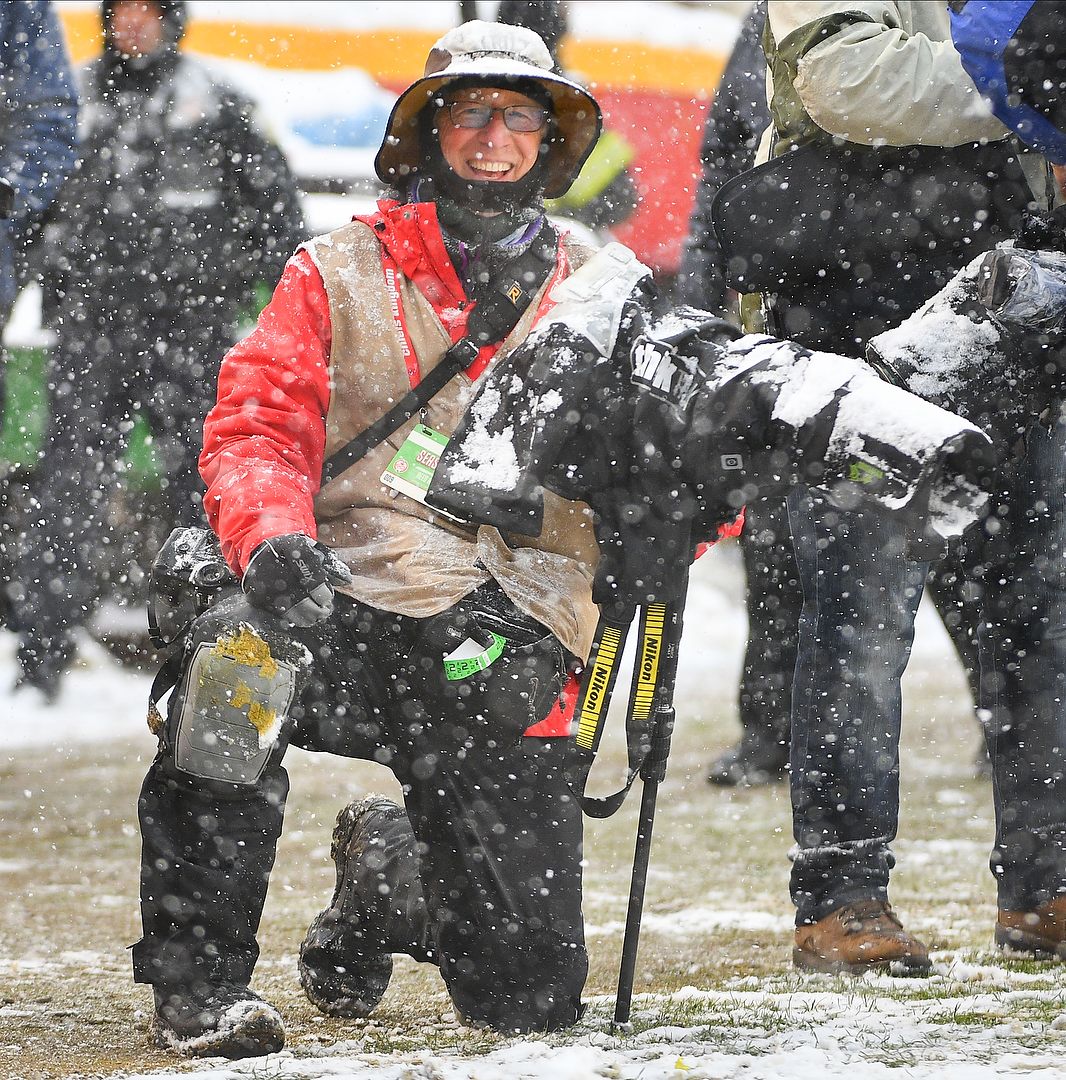
Here I am with my kit and gear. Nikon D5 and 200-400mm f/4 lens with Think Tank Hydrophobia cover, Nikon D500 with Nikkor 16-80mm DX lens. Note the snow piled up on the rain cover and brim of the sun hat. Also, you can see the snow on the back of my D500, but since it hangs with the lens pointing down, the lens stays clean. And as long as the camera stays cold, the snow doesn’t melt. Photo by Denny Medley.
Changing lenses is a no-no, so at least two cameras, one with a long lens and the other a short is a must. Protecting that gear is key too, and most pros on those sidelines were sporting Think Tank Photo’s excellent rain covers. Snow blows horizontally more than rain, so the hood on my long lens probably wasn’t going keep it all out. That’s why I used an extension hood, made by a friend of mine years ago. Those extra few inches make a big difference.
Another accessory that’s great in cold weather is something called a ProDot, which sticks on top of your shutter button making it easier to find with gloves on.
The biggest difference – and challenge – in actually shooting is, no surprise, the snow. The heavier it’s coming down, the harder it is to see detail. The further you are from the action, the more snow between you and it. So trying to position yourself close to the action, and avoiding those far away shots, is important. That distance from subject with snow can also affect autofocus. Surprisingly, today’s AF systems are so good that sometimes the camera will focus on the snowflakes between you and your subject. The closer you are, the less likely that will happen. I’ve shot skiing in Colorado for the past ten years, so knew that my Nikon D5 and D500’s autofocus systems would handle the snow best if I kept my AF Area Mode in Group. I also use back-button focus, meaning the system only focuses when I press the AF button on the back of the camera, not the shutter button. Using that button I “pulse” the autofocus, punching it on and off with my thumb to keep it re-acquiring focus. That way if the focus does get off the subject, I’m forcing it back on while shooting. I also shoot the action in bursts, not just holding down and continuously firing.
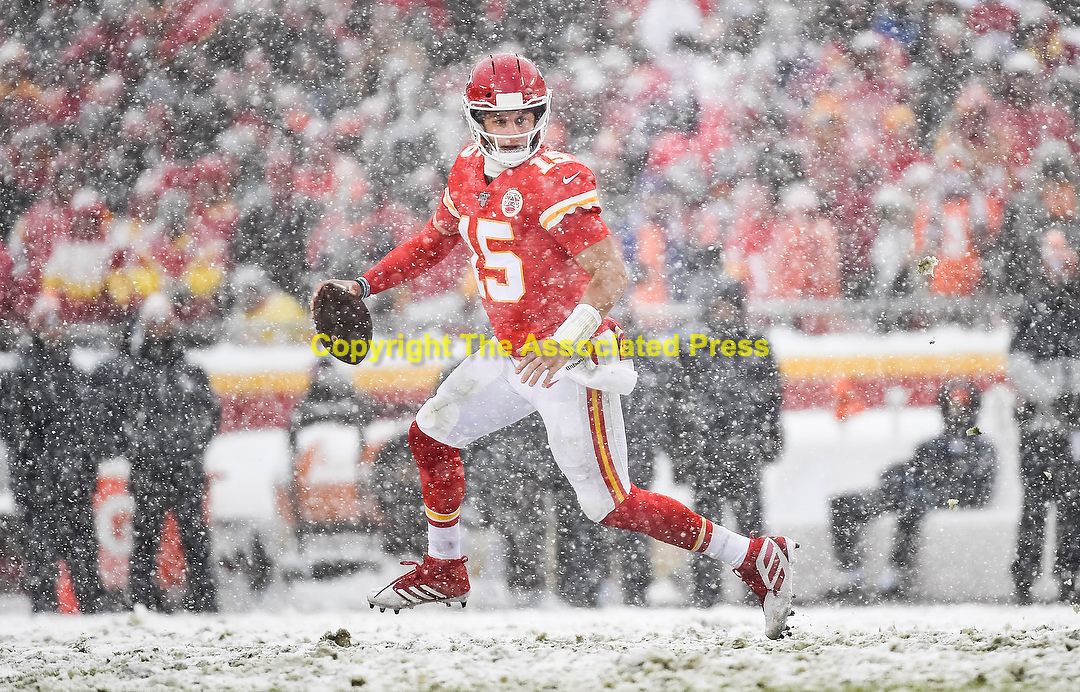
Patrick Mahomes scrambling. This was shot at 400mm in some of the heavier snow, which shows the effect that distance and quantity of snow have on image quality. Nikon D5, Aperture Priority, ISO 1000, 1/2000 at f/4, EV +.3, Nikkor 200-400mm f/4 at 400mm.
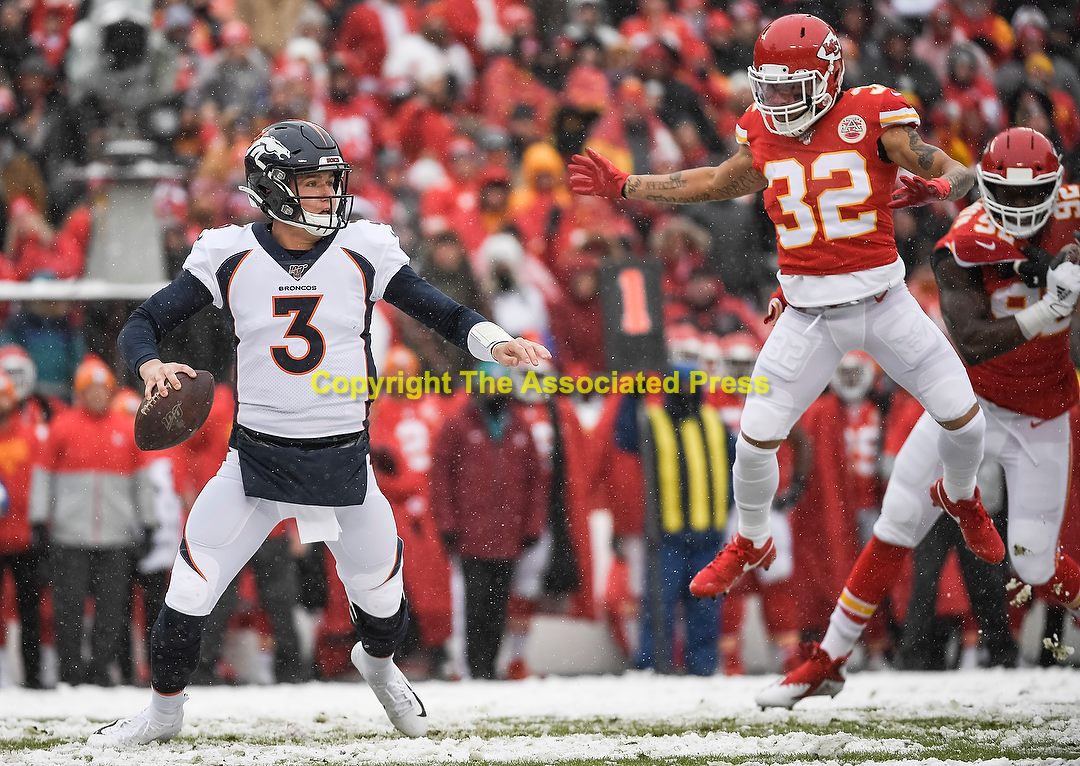
Denver’s Drew Lock is pressured by Kansas City’s Tyrann Mathieu. Shot earlier in the game, less snow falling meant a much cleaner image. Nikon D5, Aperture Priority, ISO 500, 1/3200 at f/4, EV 0.0, Nikkor 200-400mm lens at 300mm.
There was also a slight change in how I exposed. When there was a lot of snow in the frame, I added some plus exposure compensation, from +.3 to +.7. That’s standard practice for me when shooting in snow, to keep the snow appearing bright white and bring out more shadow detail in the subject. I relied on my Highlight and Histogram displays to guide me there, pushing the exposure to the right side of the Histogram, just to the edge of overexposure.
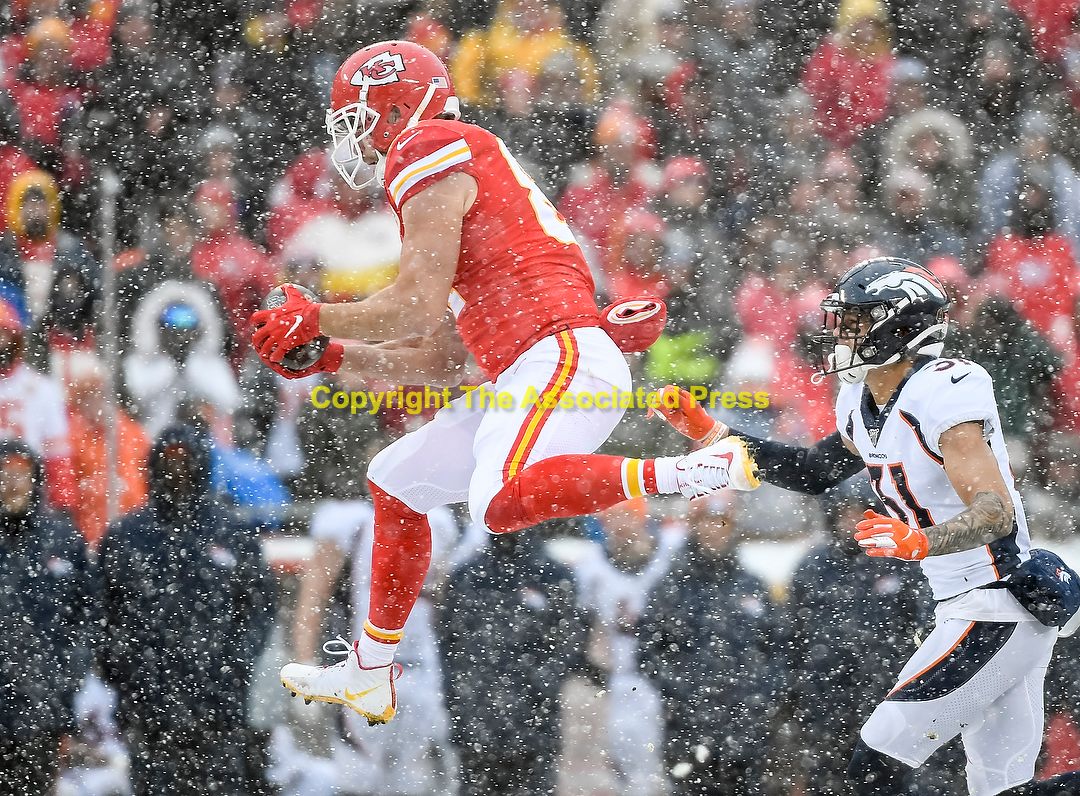
While I’d rather have more of Travis Kelce’s face in this shot, the fact that this catch set an NFL record with his fourth straight 1,000-yard receiving season made it a must-have. Nikon D5, Aperture Priority, ISO 1000, 1/1600 at f/4, EV +.7, Nikkor 200-400mm f/4 lens at 400mm.
On cold games like this, I always head outside well before the start to give my gear time to cool down. This time rather than going right out onto the field from the photo room, I waited in the unheated tunnel that leads there (for about fifteen minutes). If I’d gone straight out, not only would I risk fogging from condensation (rapid change from warm and moist to dry and cold), but more importantly, the snow would melt on the gear. Water is always bad for camera gear. That’s one advantage of shooting in the snow over the rain. If your gear is cold, the snow won’t melt on it. In fact, I took the rain cover off my second camera (the D500) after about thirty minutes. At that point the camera was cold enough that the snow just caked on the back of it, and I could blow that off anytime I needed to shoot. With the rain cover on, it would be too hard to grab the camera quickly if a play was coming at me. And since the snow wasn’t melting on it, and the lens was pointed down, there was no harm to the camera or lens.
At half-time the photographers always go back inside the photo room to download and begin editing and transmitting. If we’d done that at this game, with our cameras cold and snow-covered, we’d have had wet, fogged gear when we went back out. So one of the assistants stayed out in the tunnel and we all left our cameras there, where they stayed cold and fog-free.
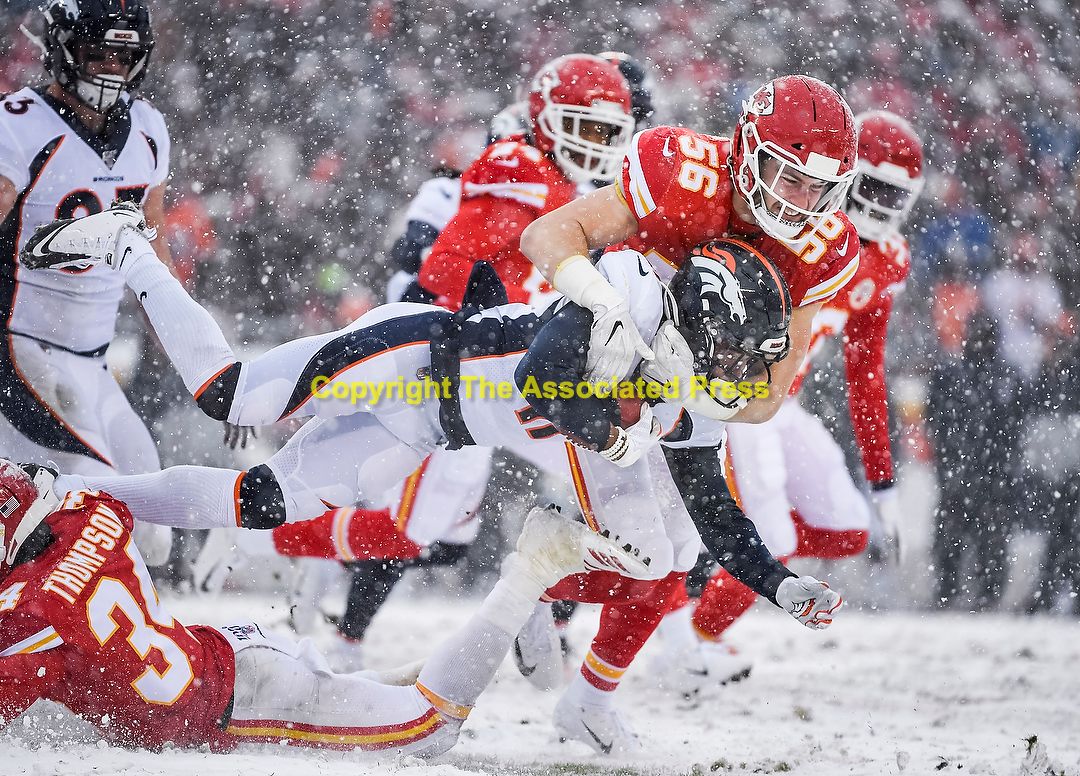
One big advantage we got from the snow was that it reflected more light into the faces of the players when they were looking down. You can see that here as Denver’s Diontae Spencer is tackled by Kansas City’s Ben Niemann. Nikon D5, Aperture Priority, ISO 800, 1/2500 at f/4, EV +.3, Nikkor 200-400mm f/4 lens at 330mm.
The last thing I do differently with a snow game is in the steps I take editing my images. Snow means lower contrast (“flatter” light), and is a bit like shooting in fog. That means I need to add contrast and take advantage of the “Dehaze” slider. Combining those two brings back some of the contrast that’s been lost.
With the combination of right gear, right accessories and a little knowledge, a snowy football game can result in some great pictures. In fact, those three can make any photo outing in snow more fun, regardless of what you’re shooting. So when I hear someone say, “It might snow,” I say “Bring it on!”
(If you like this story, please share it with your friends and let them know about the links on photography that I post on my business Facebook page. I’m also on Instagram and Twitter, @reedhoffmann. And if you’re curious about the workshops I teach, you can find them here.)

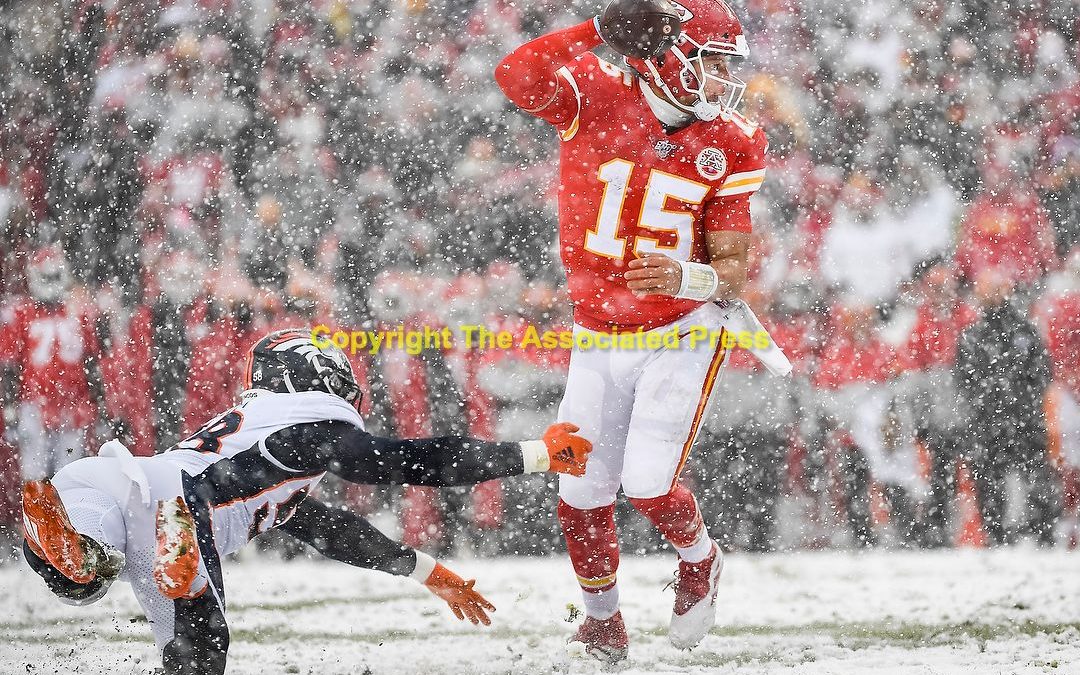
Really enjoyed reading this, thanks.
Thanks Reed. What a great tutorial. It will help me when I brave the cold and snow.
Thanks, Reed. I enjoyed your article. Even here in North Carolina, we get the occasional winter snow storm. So, your tips will be helpful when that happens again.
Being a Bronco fan, I didn’t enjoy the outcome of the game but I love the story and especially the shots.
Great story Reed & terrific tips! Thanks for sharing.
My pleasure, Norm, glad you liked it.